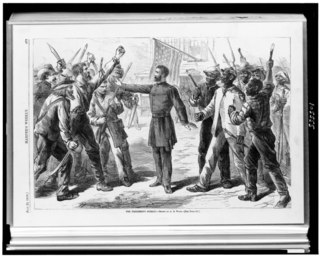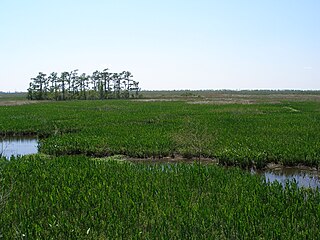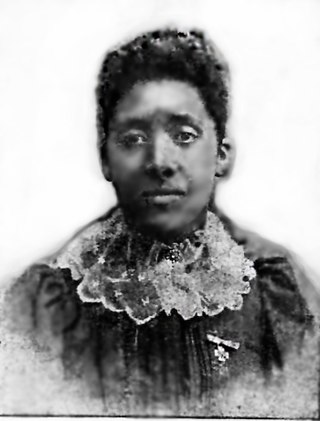
The Bureau of Refugees, Freedmen, and Abandoned Lands, usually referred to as simply the Freedmen's Bureau, was an agency of early Reconstruction, assisting freedmen in the South. It was established on March 3, 1865, and operated briefly as a U.S. government agency, from 1865 to 1872, after the American Civil War, to direct "provisions, clothing, and fuel...for the immediate and temporary shelter and supply of destitute and suffering refugees and freedmen and their wives and children".

The Knights of the White Camelia was an American political terrorist organization that operated in the Southern United States in the late 19th century. Similar to and associated with the Ku Klux Klan, it supported White supremacy and opposed freedmen's rights.

Jean Lafitte National Historical Park and Preserve protects the natural and cultural resources of Louisiana's Mississippi River Delta region. It is named after French pirate Jean Lafitte and consists of six separate sites and a park headquarters.

Fourth Ward is one of the historic six wards of Houston, Texas, United States. The Fourth Ward is located inside the 610 Loop directly west of and adjacent to Downtown Houston. The Fourth Ward is the site of Freedmen's Town, which was a post-U.S. Civil War community of African-Americans.
In the United States, a freedmen's town was an African American municipality or community built by freedmen, former slaves who were emancipated during and after the American Civil War. These towns emerged in a number of states, most notably Texas. They are also known as freedom colonies, from the title of a book by Sitton and Conrad.

The Freedmen's Bureau bills provided legislative authorization for the Freedmen's Bureau, which was set up by U.S. President Abraham Lincoln in 1865 as part of the United States Army. Following the original bill in 1865, subsequent bills sought to extend its authority and lifespan. Andrew Johnson tried to derail the bill's intention to aid freed slaves, until the Bureau was disbanded on account of rampant corruption during the first term of U.S. President Ulysses S. Grant.

Benjamin Franklin Flanders was a teacher, politician and planter in New Orleans, Louisiana. In 1867, he was appointed by the military commander as the 21st Governor of Louisiana during Reconstruction, a position which he held for some six months. He was the second and, as of 2023, the last Republican mayor of New Orleans, Louisiana.

This is a selected bibliography of the main scholarly books and articles of Reconstruction, the period after the American Civil War, 1863–1877.
Oakland Cemetery may refer to:
A freedman or freedwoman is a formerly enslaved person who has been released from slavery, usually by legal means. Historically, slaves were freed by manumission, emancipation, or self-purchase. A fugitive slave is a person who escaped enslavement by fleeing.

The Freedman's Saving and Trust Company, known as the Freedman's Savings Bank, was a private savings bank chartered by the U.S. Congress on March 3, 1865, to collect deposits from the newly emancipated communities. The bank opened 37 branches across 17 states and Washington DC within 7 years and collected funds from over 67,000 depositors. At the height of its success, the Freedman's Savings Bank held assets worth more than $3.7 million in 1872 dollars, which translates to approximately $80 million in 2021.

John Henry "Jack" Yates was an American freedman, minister, and community leader. Born enslaved in Gloucester County, Virginia, on July 11, 1828, Yates was taught to read at an early age by his enslaver's child. He married Harriet Willis, who was enslaved on a neighboring farm. When her enslaver moved his plantation to Texas to avoid emancipation, Yates, then a free man, asked to be re-enslaved in order to stay with his family. He joined his family in Matagorda County, Texas, until their emancipation in 1865. The family then relocated to Houston, where he helped establish Freedman's Town, purchased property, and began ministering to the community. In 1868, Yates was named the first full-time preacher of the Antioch Missionary Baptist Church, Houston's first Black baptist church. As a community leader, Yates organized Houston Academy, now Booker T. Washington High School; Bethel Baptist Church; and Houston's Emancipation Park. He died in 1897. Yates' original Houston home, the Jack Yates House, was donated to Houston's Heritage Society and first opened to the public in 1996.
Germany is an unincorporated community in Houston County, Texas, United States. According to the Handbook of Texas, the community had a population of 43 in 2000.

Emma Ann Reynolds (1862-1917) was an African-American teacher, who had a desire to address the health needs of her community. Refused entrance to nurses training schools because of racism, she influenced the creation of Provident Hospital in Chicago and was one of its first four nursing graduates. Continuing her education, Reynolds became a medical doctor serving at posts in Texas, Louisiana and Washington, D.C. before permanently settling in Ohio and completing her practice there.
The city of Dallas, Texas has a public art collection of over 300 individual pieces of art. Dallas Love Field Airport has almost 20 pieces of art, and Dallas/Fort Worth International Airport has over 30 more. Well known sculptures on public display include Dallas Piece by Henry Moore and Floating Sculpture by Marta Pan. Dallas has at least one Confederate memorial on public display, the Confederate War Memorial, and a memorial to freed slaves, Freedman's Memorial by David Newton, installed in 1999. Dallas Area Rapid Transit has run the DART Station Art & Design Program since 1988, and as of 2007, had about 40 installations at transit stations and Cityplace, Dallas's subway station.

The Tenth Street Freedman's Town is a historic African American community in the Oak Cliff section of Dallas, Texas. A freedmen's town is a community settled by former slaves who were emancipated during and after the American Civil War. The freedmen's town that became known as Tenth Street began near the confluence of Cedar Creek and Cedar Creek Branch, at the foot of an African American burial ground dating back to 1846. The name "Tenth Street" became associated with the community in 1887, when John Scarborough Armstrong and Thomas Lafayette Marsalis platted the town of Oak Cliff.

The Freedmen's Cemetery was a cemetery in St. Bernard Parish, Louisiana, where formerly enslaved men, women and children were buried following the end of the American Civil War. Established in 1867 as a four-acre civilian cemetery by the U.S. Bureau of Refugees, Freedmen, and Abandoned Lands, also known as the Freedmen's Bureau, it was located near the historic African American community of Fazendeville, Louisiana and adjacent to Monument Cemetery, where the U.S. government had begun burying deceased Union soldiers in 1864, many of whom had been involved in the Red River campaign.
The Freedman's Cemetery was established in 1861 as a burial ground for the early African American population in Dallas, Texas. It was an active burial site from 1869 until 1907, supported by the historic Black settlement of Freeman's town founded by formerly enslaved people.











